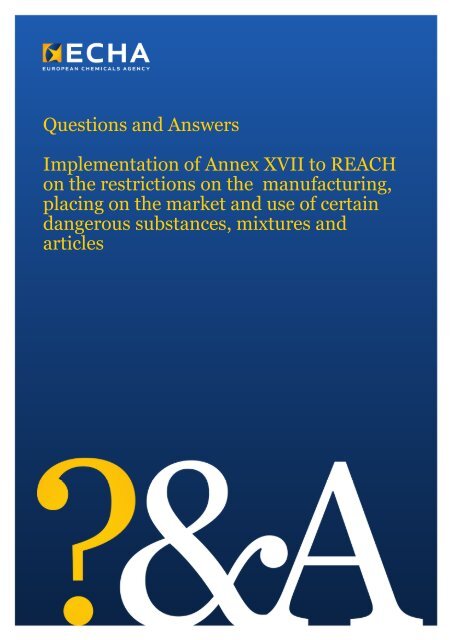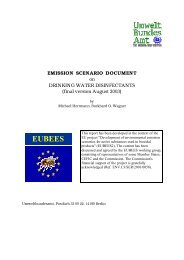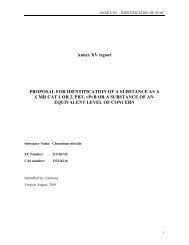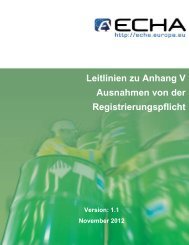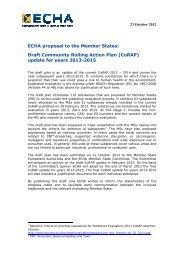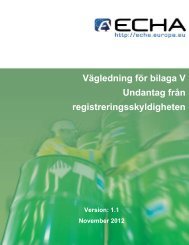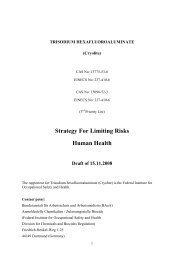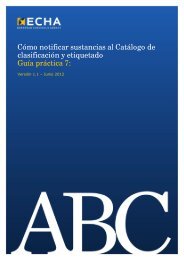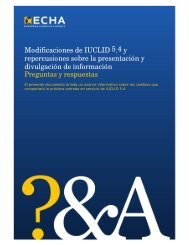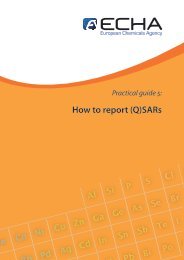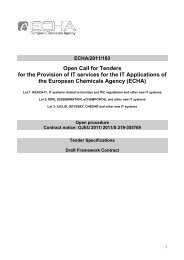Questions and answers on restrictions - ECHA - Europa
Questions and answers on restrictions - ECHA - Europa
Questions and answers on restrictions - ECHA - Europa
Create successful ePaper yourself
Turn your PDF publications into a flip-book with our unique Google optimized e-Paper software.
<str<strong>on</strong>g>Questi<strong>on</strong>s</str<strong>on</strong>g> <str<strong>on</strong>g>and</str<strong>on</strong>g> Answers<br />
Implementati<strong>on</strong> of Annex XVII to REACH<br />
<strong>on</strong> the restricti<strong>on</strong>s <strong>on</strong> the manufacturing,<br />
placing <strong>on</strong> the market <str<strong>on</strong>g>and</str<strong>on</strong>g> use of certain<br />
dangerous substances, mixtures <str<strong>on</strong>g>and</str<strong>on</strong>g><br />
articles
2<br />
Q&A<br />
Implementati<strong>on</strong> of Annex XVII to REACH <strong>on</strong> restricti<strong>on</strong>s<br />
<str<strong>on</strong>g>Questi<strong>on</strong>s</str<strong>on</strong>g> <str<strong>on</strong>g>and</str<strong>on</strong>g> Answers <strong>on</strong> the implementati<strong>on</strong> of Annex XVII to REACH <strong>on</strong> the<br />
restricti<strong>on</strong>s <strong>on</strong> the manufacturing, placing <strong>on</strong> the market <str<strong>on</strong>g>and</str<strong>on</strong>g> use of certain<br />
dangerous substances, mixtures <str<strong>on</strong>g>and</str<strong>on</strong>g> articles<br />
Reference: <strong>ECHA</strong>-12-QA-05-EN<br />
Publ.date: July 2012<br />
Language: EN<br />
© European Chemicals Agency, 2012<br />
Cover page © European Chemicals Agency<br />
Reproducti<strong>on</strong> is authorised provided the source is fully acknowledged in the form<br />
“Source: European Chemicals Agency, http://echa.europa.eu/”, <str<strong>on</strong>g>and</str<strong>on</strong>g> provided written<br />
notificati<strong>on</strong> is given to the <strong>ECHA</strong> Communicati<strong>on</strong> Unit (publicati<strong>on</strong>s@echa.europa.eu).<br />
If you have questi<strong>on</strong>s or comments in relati<strong>on</strong> to this document please send them (quote the<br />
reference <str<strong>on</strong>g>and</str<strong>on</strong>g> issue date) using the informati<strong>on</strong> request form. The informati<strong>on</strong> request form<br />
can be accessed via the C<strong>on</strong>tact <strong>ECHA</strong> page at:<br />
http://echa.europa.eu/about/c<strong>on</strong>tact_en.asp<br />
European Chemicals Agency<br />
Mailing address: P.O. Box 400, FI-00121 Helsinki, Finl<str<strong>on</strong>g>and</str<strong>on</strong>g><br />
Visiting address: Annankatu 18, Helsinki, Finl<str<strong>on</strong>g>and</str<strong>on</strong>g>
Q&A<br />
Implementati<strong>on</strong> of Annex XVII to REACH <strong>on</strong> restricti<strong>on</strong>s<br />
Table of C<strong>on</strong>tents<br />
INTRODUCTION.......................................................................................................... 4<br />
1. MERCURY (ENTRY 18(A) OF ANNEX XVII TO REACH) ............................................. 5<br />
2. ARSENIC COMPOUNDS (ENTRY 19 TO ANNEX XVII) ............................................... 6<br />
2.1 Status of imported CCA treated wood...................................................................... 6<br />
2.2 Applicati<strong>on</strong>s of wood treated with CCA Type C.......................................................... 6<br />
3. CADMIUM AND ITS COMPOUNDS (ENTRY 23 OF ANNEX XVII TO REACH) ............... 7<br />
4. NICKEL AND ITS COMPOUNDS (ENTRY 27 OF ANNEX XVII TO REACH)................... 7<br />
5. CMR SUBSTANCES (ENTRIES 28 TO 30 OF ANNEX XVII TO REACH) ....................... 8<br />
6. FLAMMABLE SUBSTANCES IN AEROSOL GENERATORS FOR ENTERTAINMENT AND<br />
DECORATIVE PURPOSES (ENTRY 40 OF ANNEX XVII TO REACH).......................... 8<br />
7. NONYLPHENOL (ENTRY 46 OF ANNEX XVII TO REACH ) ......................................... 9<br />
8. TOLUENE (ENTRY 48 OF ANNEX XVII TO REACH) ................................................... 9<br />
9. AZOCOLORANTS AND AZODYES (ENTRY 43 OF ANNEX XVII TO REACH) ............... 10<br />
10. PAH IN EXTENDER OILS AND TYRES (ENTRY 50 OF ANNEX XVII TO REACH)...... 10<br />
10.1 Interpretati<strong>on</strong> of the term “major operati<strong>on</strong>al change” ............................................ 10<br />
10.2 Tyres for mobile machinery.................................................................................. 11<br />
10.3 St<str<strong>on</strong>g>and</str<strong>on</strong>g>ard reference tyres ..................................................................................... 12<br />
11. PHTHALATES IN TOYS AND CHILDCARE ARTICLES (ENTRIES 51 AND 52 OF<br />
ANNEX XVII TO REACH)...................................................................................... 12<br />
11.1 Traces of phthalates in toys <str<strong>on</strong>g>and</str<strong>on</strong>g> childcare articles................................................... 12<br />
11.2 Phthalates in articles used for the hygiene of children.............................................. 13<br />
11.3 Mattress protectors ............................................................................................. 13<br />
11.4 Di-2-propyl heptyl phthalate (DPHP), CAS No 53306-54-0 ....................................... 14<br />
12. METHYLENEDIPHENYL DIISOCYANATE (MDI) (ENTRY 56 OF ANNEX XVII TO<br />
REACH)............................................................................................................... 14<br />
13. AMONIUM NITRATE (ENTRY 58 OF ANNEX XVII TO REACH) ............................... 15<br />
3
Introducti<strong>on</strong><br />
This document gathers questi<strong>on</strong>s <str<strong>on</strong>g>and</str<strong>on</strong>g> agreed <str<strong>on</strong>g>answers</str<strong>on</strong>g> c<strong>on</strong>cerning the interpretati<strong>on</strong> of the<br />
provisi<strong>on</strong>s in Annex XVII to Regulati<strong>on</strong> (EC) No 1907/2006 of the European Parliament <str<strong>on</strong>g>and</str<strong>on</strong>g> of<br />
the Council of 18 December 2006 c<strong>on</strong>cerning the Registrati<strong>on</strong>, Evaluati<strong>on</strong>, Authorisati<strong>on</strong> <str<strong>on</strong>g>and</str<strong>on</strong>g><br />
Restricti<strong>on</strong> of Chemicals (REACH).<br />
These replies were first developed for the purpose of implementing Council Directive<br />
76/769/EEC of 27 July 1976 <strong>on</strong> the approximati<strong>on</strong> of the laws, regulati<strong>on</strong>s <str<strong>on</strong>g>and</str<strong>on</strong>g> administrative<br />
provisi<strong>on</strong>s of the Member States relating to restricti<strong>on</strong>s <strong>on</strong> the marketing <str<strong>on</strong>g>and</str<strong>on</strong>g> use of certain<br />
dangerous substances <str<strong>on</strong>g>and</str<strong>on</strong>g> preparati<strong>on</strong>s. These questi<strong>on</strong>s <str<strong>on</strong>g>and</str<strong>on</strong>g> <str<strong>on</strong>g>answers</str<strong>on</strong>g> will be complemented<br />
by further questi<strong>on</strong>s <str<strong>on</strong>g>and</str<strong>on</strong>g> <str<strong>on</strong>g>answers</str<strong>on</strong>g>, if <str<strong>on</strong>g>and</str<strong>on</strong>g> when they arise from the implementati<strong>on</strong> of Annex<br />
XVII to REACH.<br />
The <str<strong>on</strong>g>answers</str<strong>on</strong>g> are attempted to provide guidance to both Member States <str<strong>on</strong>g>and</str<strong>on</strong>g> ec<strong>on</strong>omic<br />
operators.<br />
This guidance document does not c<strong>on</strong>stitute any formal commitment <strong>on</strong> behalf of the<br />
Commissi<strong>on</strong>. Only the European Court of Justice can give an authoritative interpretati<strong>on</strong> of<br />
Community legislati<strong>on</strong>.
1. Mercury (Entry 18(a) of Annex XVII to REACH)<br />
Repairing <str<strong>on</strong>g>and</str<strong>on</strong>g> maintenance activities<br />
The questi<strong>on</strong> was raised as to whether the repairing <str<strong>on</strong>g>and</str<strong>on</strong>g> maintenance activities are covered by<br />
the restricti<strong>on</strong> in Entry 18(a) of annex XVII to REACH.<br />
Fever thermometers <str<strong>on</strong>g>and</str<strong>on</strong>g> other measuring devices for sale to the general public in use in the<br />
European Uni<strong>on</strong> before the 3 April 2009:<br />
The prohibiti<strong>on</strong> c<strong>on</strong>cerns the placing <strong>on</strong> the market of fever thermometers <str<strong>on</strong>g>and</str<strong>on</strong>g> other<br />
measuring devices for sale to the general public after the 3 April 2009.<br />
Pursuant to paragraph 2, thermometers as well as other measuring devices for sale to the<br />
general public in use in the European Uni<strong>on</strong> before the 3 April 2009 are exempted from the<br />
prohibiti<strong>on</strong>. These instruments c<strong>on</strong>taining mercury which were in use in the European Uni<strong>on</strong><br />
before the 3 April 2009 can be placed <strong>on</strong> the sec<strong>on</strong>d h<str<strong>on</strong>g>and</str<strong>on</strong>g> market except in the territories of<br />
Member States which decided to regulate theses existing instruments.<br />
Repairing <str<strong>on</strong>g>and</str<strong>on</strong>g> maintenance activities for these existing instruments are excluded from the<br />
scope of the restricti<strong>on</strong>.<br />
Nevertheless, in the case of repairing <str<strong>on</strong>g>and</str<strong>on</strong>g> maintenance activities performed <strong>on</strong> these<br />
devices, new measuring devices c<strong>on</strong>taining mercury shall not be used as this would be<br />
c<strong>on</strong>sidered making available new measuring devices to the general public.<br />
Antique Barometers<br />
Under 18(a) antiques measuring devices are defined as more than 50 years old <strong>on</strong> 3 October<br />
2007.<br />
Under paragraph 3 antique measuring devices are exempted from the restricti<strong>on</strong>. Repairing<br />
<str<strong>on</strong>g>and</str<strong>on</strong>g> maintenance activities for these antique measuring devices are also exempted for the<br />
restricti<strong>on</strong>.<br />
The intenti<strong>on</strong> of the legislator in granting an exempti<strong>on</strong> for antique measuring devices is that<br />
their trade should c<strong>on</strong>tinue (Directive 2007/51/EC, Recital No 4) due to their cultural <str<strong>on</strong>g>and</str<strong>on</strong>g>/or<br />
historical value. Therefore these instruments should c<strong>on</strong>tinue to be serviced in order to keep<br />
their cultural <str<strong>on</strong>g>and</str<strong>on</strong>g>/or historical value.<br />
Antique measuring devices such as barometers c<strong>on</strong>taining two columns of mercury which <strong>on</strong>e<br />
c<strong>on</strong>sists of a thermometer are c<strong>on</strong>sidered falling within the derogati<strong>on</strong> of paragraph 3 <str<strong>on</strong>g>and</str<strong>on</strong>g><br />
therefore they should c<strong>on</strong>tinue to be serviced. The columns can be repaired or replaced if<br />
these activities are part of the maintenance <str<strong>on</strong>g>and</str<strong>on</strong>g> repair services <str<strong>on</strong>g>and</str<strong>on</strong>g> preserve the cultural<br />
<str<strong>on</strong>g>and</str<strong>on</strong>g>/or historical value of the instrument.<br />
Professi<strong>on</strong>als may buy measuring devices c<strong>on</strong>taining mercury if they are destined for the repair<br />
<str<strong>on</strong>g>and</str<strong>on</strong>g> maintenance activities of antique measuring devices.
2. Arsenic Compounds (Entry 19 to Annex XVII)<br />
2.1 Status of imported CCA treated wood<br />
Are imports of CCA treated wood from outside the European Uni<strong>on</strong> banned under<br />
Entry 19 of Annex XVII?<br />
Under Entry 19 of Annex XVII to REACH, CCA type C cannot be used to treat wood in the EU<br />
due to the fact that it has not been authorised under Directive 98/8/EC. A request for<br />
authorisati<strong>on</strong> could, however, be made in the future in line with the requirements of Directive<br />
98/8/EC.<br />
C<strong>on</strong>cerning wood newly treated with CCA type C <str<strong>on</strong>g>and</str<strong>on</strong>g> imported from third countries:<br />
• paragraph 4 a) authorises <strong>on</strong>ly the treatment of wood with CCA type C if this biocidal<br />
product is authorised under Directive 98/8/EC.<br />
• under paragraph 4 b) it is stated that “Wood treated with CCA soluti<strong>on</strong>s in accordance<br />
with point a) may ….”<br />
This implies that all wood that is placed <strong>on</strong> the market in the EU must c<strong>on</strong>form to the<br />
requirements of paragraph 4 a).<br />
Therefore wood newly treated with CCA type C may <strong>on</strong>ly be placed <strong>on</strong> the EU market if this<br />
biocidal product used for treatment is authorised under Directive 98/8/EC.<br />
Whilst the Directive does not impose general obligati<strong>on</strong>s <strong>on</strong> wood treatment installati<strong>on</strong>s<br />
outside the EU, this requirement is valid for any manufacturer, distributor, or importer placing<br />
wood <strong>on</strong> the EU market whether this wood is manufactured in the EU or manufactured outside<br />
the EU <str<strong>on</strong>g>and</str<strong>on</strong>g> imported. Obviously the requirement does not apply to wood treatment<br />
installati<strong>on</strong>s outside the EU producing wood for marketing outside the EU.<br />
In summary since 30 June 2007, it is prohibited to place <strong>on</strong> the market <str<strong>on</strong>g>and</str<strong>on</strong>g> to import wood<br />
newly treated with CCA type C, until such time as a biocidal product c<strong>on</strong>taining this active<br />
substance is authorised in line with all the requirements of Directive 98/8/EC.<br />
2.2 Applicati<strong>on</strong>s of wood treated with CCA Type C<br />
Under Entry 19, paragraph 4b) of Annex XVII to REACH there is a list of applicati<strong>on</strong>s for which<br />
wood treated with CCA type C can be used. May treated wood be used for other applicati<strong>on</strong>s,<br />
such as railway sleepers other than underground railway sleepers?<br />
Paragraph 4b) of Annex XVII to REACH c<strong>on</strong>cerning arsenic compounds provides for a list of<br />
applicati<strong>on</strong>s for which wood treated with CCA may be used. This is not a list of examples of<br />
possible uses but a limitative list of authorised applicati<strong>on</strong>s.<br />
C<strong>on</strong>sequently, wood treated with CCA cannot be used for other applicati<strong>on</strong>s than the <strong>on</strong>es<br />
listed in paragraph 4 b). Wood treated with CCA can, therefore, not be used for railway<br />
sleepers installed above ground.
3. Cadmium <str<strong>on</strong>g>and</str<strong>on</strong>g> its compounds (entry 23 of Annex XVII to<br />
REACH)<br />
Paragraphs 10 <str<strong>on</strong>g>and</str<strong>on</strong>g> 11, clarificati<strong>on</strong> regarding the meaning of the placing <strong>on</strong> the<br />
market <str<strong>on</strong>g>and</str<strong>on</strong>g> the derogati<strong>on</strong><br />
A questi<strong>on</strong> was raised in order to know whether the sale of jewellery articles c<strong>on</strong>taining more<br />
than 0.01% of Cadmium, manufactured <str<strong>on</strong>g>and</str<strong>on</strong>g> already placed <strong>on</strong> the market (e.g. sold by the<br />
manufacturer to the distributor) before the 10 December 2011 could c<strong>on</strong>tinue to be placed <strong>on</strong><br />
the market following the entry into force of the new restricti<strong>on</strong>.<br />
The prohibiti<strong>on</strong> of the placing <strong>on</strong> the market of jewellery <str<strong>on</strong>g>and</str<strong>on</strong>g> imitati<strong>on</strong> jewellery articles<br />
c<strong>on</strong>taining cadmium includes sales from the manufacturers to distributors <str<strong>on</strong>g>and</str<strong>on</strong>g> from distributors<br />
to retailers, as well as imports.<br />
However, Commissi<strong>on</strong> Regulati<strong>on</strong> (EU) 494/2011 c<strong>on</strong>tains derogati<strong>on</strong> for articles that were<br />
placed <strong>on</strong> the market before 10 December 2011 (for the date see corrigendum published in OJ<br />
L 136/105). This means that jewellery <str<strong>on</strong>g>and</str<strong>on</strong>g> imitati<strong>on</strong> jewellery articles placed <strong>on</strong> the market for<br />
the first time before 10 December 2011 do not need to comply with the prohibiti<strong>on</strong> thus they<br />
can be sold following entry into force of the new restricti<strong>on</strong> for example to a retailer or <strong>on</strong> the<br />
sec<strong>on</strong>d-h<str<strong>on</strong>g>and</str<strong>on</strong>g> market.<br />
4. Nickel <str<strong>on</strong>g>and</str<strong>on</strong>g> its compounds (Entry 27 of Annex XVII to<br />
REACH)<br />
Mobile teleph<strong>on</strong>es<br />
The questi<strong>on</strong> was raised whether mobile teleph<strong>on</strong>es are covered by the restricti<strong>on</strong> set in entry<br />
27 of annex XVII to REACH <strong>on</strong> nickel.<br />
Entry 27 of Annex XVII to REACH states that nickel may not be used “in articles intended to<br />
come into direct <str<strong>on</strong>g>and</str<strong>on</strong>g> prol<strong>on</strong>ged c<strong>on</strong>tact with the skin, if the rate of nickel release from the<br />
parts of these articles coming into direct <str<strong>on</strong>g>and</str<strong>on</strong>g> prol<strong>on</strong>ged c<strong>on</strong>tact with the skin is greater than<br />
0.5 µg/cm²/week”.<br />
The aim of this restricti<strong>on</strong> to protect c<strong>on</strong>sumers against nickel allergy which may be caused by<br />
prol<strong>on</strong>ged c<strong>on</strong>tact of the skin with nickel-releasing articles that come into direct <str<strong>on</strong>g>and</str<strong>on</strong>g> prol<strong>on</strong>ged<br />
c<strong>on</strong>tact with the skin such as jewellery, butt<strong>on</strong>s, tighteners, zips <str<strong>on</strong>g>and</str<strong>on</strong>g> rivets in items of clothing.<br />
It has emerged that some mobile teleph<strong>on</strong>es c<strong>on</strong>tain nickel in surface material <str<strong>on</strong>g>and</str<strong>on</strong>g> that<br />
c<strong>on</strong>sumers are at risk of developing eczema through skin c<strong>on</strong>tact with the mobile teleph<strong>on</strong>e.<br />
As mobile teleph<strong>on</strong>es are clearly intended to come into direct c<strong>on</strong>tact with the skin, <str<strong>on</strong>g>and</str<strong>on</strong>g> as<br />
they are used <strong>on</strong> a daily basis often for prol<strong>on</strong>ged periods of time, it is c<strong>on</strong>sidered that mobile<br />
teleph<strong>on</strong>es fulfil the c<strong>on</strong>diti<strong>on</strong> of “direct <str<strong>on</strong>g>and</str<strong>on</strong>g> prol<strong>on</strong>ged c<strong>on</strong>tact with the skin”. Therefore mobile<br />
teleph<strong>on</strong>es are covered by the restricti<strong>on</strong> <str<strong>on</strong>g>and</str<strong>on</strong>g> should comply with the c<strong>on</strong>diti<strong>on</strong>s set in Entry 27<br />
of Annex XVII to REACH.
5. CMR substances (Entries 28 to 30 of Annex XVII to<br />
REACH)<br />
C<strong>on</strong>centrati<strong>on</strong> limits<br />
Entries 28 to 30 of Annex XVII to REACH prohibit the placing <strong>on</strong> the market <str<strong>on</strong>g>and</str<strong>on</strong>g> use of<br />
mixtures when the c<strong>on</strong>centrati<strong>on</strong> limit is greater than<br />
• either the relevant specific c<strong>on</strong>centrati<strong>on</strong> limit specified in Part 3 of Annex VI to<br />
Regulati<strong>on</strong> (EC) No 1272/2008, or,<br />
• the relevant c<strong>on</strong>centrati<strong>on</strong> specified in Directive 1999/45/EC.<br />
The questi<strong>on</strong> was raised by operators <strong>on</strong> the interpretati<strong>on</strong> of this provisi<strong>on</strong> in the case of a<br />
mixture for which a specific c<strong>on</strong>centrati<strong>on</strong> limit is specified in Part 3 of Annex VI to Regulati<strong>on</strong><br />
(EC) No 1272/2008.<br />
Should this specific c<strong>on</strong>centrati<strong>on</strong> limit be c<strong>on</strong>sidered for the implementati<strong>on</strong> of the restricti<strong>on</strong>?<br />
Do operators have a choice between the specific c<strong>on</strong>centrati<strong>on</strong> limit <str<strong>on</strong>g>and</str<strong>on</strong>g> the c<strong>on</strong>centrati<strong>on</strong><br />
specified in Directive 1999/45/EC?<br />
Whenever a specific c<strong>on</strong>centrati<strong>on</strong> limit is specified for a particular substance in Part 3 of<br />
Annex VI to Regulati<strong>on</strong> (EC) No 1272/2008, then the restricti<strong>on</strong> in entries 28 to 30 of Annex<br />
XVII of REACH will apply to the mixtures which c<strong>on</strong>tain the substance at a<br />
c<strong>on</strong>centrati<strong>on</strong> greater than that specific c<strong>on</strong>centrati<strong>on</strong>.<br />
Operators <str<strong>on</strong>g>and</str<strong>on</strong>g> Competent Authorities may not choose between the generic <str<strong>on</strong>g>and</str<strong>on</strong>g> the specific<br />
c<strong>on</strong>centrati<strong>on</strong> limits but they should use the specific c<strong>on</strong>centrati<strong>on</strong> limit as specified in Part 3 of<br />
Annex VI to Regulati<strong>on</strong> (EC) No 1272/2008 in order to implement the restricti<strong>on</strong>.<br />
In case no relevant specific c<strong>on</strong>centrati<strong>on</strong> limit is specified in Part 3 of Annex VI to Regulati<strong>on</strong><br />
(EC) No 1272/2008, then, the relevant c<strong>on</strong>centrati<strong>on</strong> specified in Directive 1999/45/EC should<br />
be used.<br />
6. Flammable substances in aerosol generators for<br />
entertainment <str<strong>on</strong>g>and</str<strong>on</strong>g> decorative purposes (Entry 40 of Annex<br />
XVII to REACH)<br />
Aerosol generators c<strong>on</strong>taining coloured hairsprays <str<strong>on</strong>g>and</str<strong>on</strong>g> glitter for the body<br />
Entry 40 of Annex XVII to REACH prohibits the use of flammable, highly flammable or<br />
extremely flammable substances in “aerosol generators placed <strong>on</strong> the market for the general<br />
public for entertainment <str<strong>on</strong>g>and</str<strong>on</strong>g> decorative purposes”.<br />
A questi<strong>on</strong> was raised whether aerosol generators c<strong>on</strong>taining coloured hairsprays <str<strong>on</strong>g>and</str<strong>on</strong>g> glitter<br />
for the body <str<strong>on</strong>g>and</str<strong>on</strong>g> sold to the general public are restricted under this entry.<br />
Entry 40 establishes a n<strong>on</strong>-exhaustive list of examples of products that are covered by the<br />
restricti<strong>on</strong>. These examples are all products to be used for decorati<strong>on</strong> of venues of<br />
festivities/parties <str<strong>on</strong>g>and</str<strong>on</strong>g> for use during parties. N<strong>on</strong>e of these examples are cosmetic products.<br />
Cosmetic products are covered under Directive 76/768/EEC1. Coloured hair sprays <str<strong>on</strong>g>and</str<strong>on</strong>g> body<br />
glitter enter in the definiti<strong>on</strong> of cosmetic products as they are intended “to be placed in c<strong>on</strong>tact<br />
with an external part of the human body” with a view to “changing its appearance”. They have<br />
1 OJ L 262, 27.9.1976, p.169
a similar use as the more classical cosmetic products, such as normal hair sprays <str<strong>on</strong>g>and</str<strong>on</strong>g> should<br />
not be c<strong>on</strong>sidered as having an entertainment purpose.<br />
For these reas<strong>on</strong> it is c<strong>on</strong>sidered that Entry 40 does not cover aerosols dispensers c<strong>on</strong>taining<br />
cosmetic products which are also covered by Directive 76/768/EEC.<br />
Moreover Article 67 of REACH excludes cosmetics products from the scope of the restricti<strong>on</strong>s<br />
when the restricti<strong>on</strong> is targeting a risk for human health. This restricti<strong>on</strong> <strong>on</strong> aerosol dispensers<br />
is entirely linked with human health.<br />
C<strong>on</strong>clusi<strong>on</strong>: The restricti<strong>on</strong> in Entry 40 of Annex XVII to REACH, prohibiting the use of<br />
flammable, highly flammable or extremely flammable substances in “aerosol generators<br />
placed <strong>on</strong> the market for the general public for entertainment <str<strong>on</strong>g>and</str<strong>on</strong>g> decorative purposes” does<br />
not cover aerosol dispensers which c<strong>on</strong>tain cosmetic products.<br />
7. N<strong>on</strong>ylphenol (Entry 46 of Annex XVII to REACH )<br />
Traces in cosmetic products<br />
Directive 76/768/EEC relating to cosmetic products, as amended by Commissi<strong>on</strong> Directive<br />
2005/80/EC2, introduces a ban <strong>on</strong> the marketing of cosmetic products c<strong>on</strong>taining n<strong>on</strong>ylphenol<br />
(CAS: 25154-52-3) <str<strong>on</strong>g>and</str<strong>on</strong>g> 4-n<strong>on</strong>ylphenol, branched (CAS: 84852-15-3) (entry 1168 of Annex II).<br />
Article 4 §2 of Directive 76/768/EEC allows the presence of traces in products provided that<br />
such presence is technically unavoidable in good manufacturing practice <str<strong>on</strong>g>and</str<strong>on</strong>g> that the product<br />
does not cause damage to human health.<br />
Entry 46 of Annex XVII to REACH bans the placing <strong>on</strong> the market of n<strong>on</strong>ylphenol <str<strong>on</strong>g>and</str<strong>on</strong>g><br />
n<strong>on</strong>ylphenol ethoxylates as a substance or in mixtures in a number of applicati<strong>on</strong>s including<br />
cosmetic products, when the c<strong>on</strong>centrati<strong>on</strong> is higher than 0.1% by weight.<br />
Although the two texts pursue the same objective <str<strong>on</strong>g>and</str<strong>on</strong>g> impose the same restricti<strong>on</strong>, they<br />
diverge c<strong>on</strong>cerning the tolerance of trace c<strong>on</strong>taminati<strong>on</strong>.<br />
8. Toluene (Entry 48 of Annex XVII to REACH)<br />
Toluene in Adhesive Tapes<br />
For adhesive tapes, does the c<strong>on</strong>centrati<strong>on</strong> limit for toluene of 0.1% in adhesives apply to the<br />
whole mass of the tape or just to the mass of the adhesive layer <strong>on</strong> the tape?<br />
Entry 48 prohibits the placing <strong>on</strong> the market for supply to the general public of toluene as a<br />
substance or in mixtures, in a c<strong>on</strong>centrati<strong>on</strong> equal to or greater than 0.1% by weight, where<br />
the substance or the mixture is used in adhesives <str<strong>on</strong>g>and</str<strong>on</strong>g> spray paints.<br />
Adhesive tapes c<strong>on</strong>sist of a layer of adhesive coated <strong>on</strong> a flexible substrate. As the restricti<strong>on</strong><br />
c<strong>on</strong>cerns the c<strong>on</strong>centrati<strong>on</strong> of toluene in adhesives, the c<strong>on</strong>centrati<strong>on</strong> of toluene must be<br />
calculated with reference to the amount of adhesive <strong>on</strong> the tape, <str<strong>on</strong>g>and</str<strong>on</strong>g> not with reference to the<br />
total weight of the adhesive <str<strong>on</strong>g>and</str<strong>on</strong>g> substrate.<br />
2 OJ L 303, 22.11.2005, p. 32
9. Azocolorants <str<strong>on</strong>g>and</str<strong>on</strong>g> Azodyes (Entry 43 OF ANNEX XVII to<br />
REACH)<br />
Optical brightening agents<br />
Are optical brightening agents (OBAs) azodyes within the meaning of the Entry 43?<br />
Answer: Through a literature search <str<strong>on</strong>g>and</str<strong>on</strong>g> c<strong>on</strong>sultati<strong>on</strong> with experts in this area it was not<br />
found any structural c<strong>on</strong>necti<strong>on</strong> between optical brighteners (or better called fluorescent dyes)<br />
<str<strong>on</strong>g>and</str<strong>on</strong>g> azodyes since either the NH b<strong>on</strong>ds in the fluorescent dyes are c<strong>on</strong>nected to heterocyclic N-<br />
C structures <str<strong>on</strong>g>and</str<strong>on</strong>g> therefore cannot form any of the 22 banned arylamines or they do not<br />
c<strong>on</strong>tain any azo b<strong>on</strong>ds where reductive cleavage could take place to generate any of the<br />
aromatic amines covered by the azodyes ban.<br />
Therefore at the present time, this informati<strong>on</strong> c<strong>on</strong>firms that the restricti<strong>on</strong> in Entry 43 to<br />
Annex XVII does not cover optical brightening agents (OBAs). Should the chemical structure of<br />
optical brightening agents be different from the definiti<strong>on</strong> as reported above, this answer may<br />
change accordingly.<br />
10. PAH in extender oils <str<strong>on</strong>g>and</str<strong>on</strong>g> tyres (Entry 50 of Annex XVII<br />
to REACH)<br />
10.1 Interpretati<strong>on</strong> of the term “major operati<strong>on</strong>al change”<br />
<str<strong>on</strong>g>Questi<strong>on</strong>s</str<strong>on</strong>g> have arisen c<strong>on</strong>cerning the requirement to c<strong>on</strong>trol the calibrati<strong>on</strong> of the PAH/PCA<br />
ratio after each “major operati<strong>on</strong>al change” under Entry 50 to Annex XVII.<br />
As stated in Recital 8 of the Directive 2005/69/EC3, there are at present no harm<strong>on</strong>ized test<br />
methods for measuring PAHs in the extender oils, or for measuring PAHs in tyres that c<strong>on</strong>tain<br />
such oils. Until suitable harm<strong>on</strong>ized methods are available, the <strong>on</strong>ly named method that is<br />
permitted for measuring the PAH c<strong>on</strong>tent of extender oils is the IP346 analysis method. This<br />
method is permitted providing that certain additi<strong>on</strong>al c<strong>on</strong>diti<strong>on</strong>s are met. These additi<strong>on</strong>al<br />
c<strong>on</strong>diti<strong>on</strong>s are necessary because the IP346 method does not measure the PAH c<strong>on</strong>tent<br />
directly.<br />
In fact IP346 measures the total c<strong>on</strong>tent of polycyclic aromatic compounds (PCA) rather than<br />
the PAH c<strong>on</strong>tent. The PCAs are a group of substances to which PAHs bel<strong>on</strong>g, but in which PAHs<br />
are present in <strong>on</strong>ly very small amounts. The legal limit for PAHs in extender oils, which is 1<br />
part per milli<strong>on</strong> (ppm) of BaP <str<strong>on</strong>g>and</str<strong>on</strong>g> 10ppm total PAH c<strong>on</strong>tent, is c<strong>on</strong>sidered to be met if the total<br />
PCA c<strong>on</strong>tent is
the <strong>on</strong>ly substances that affect the refractive index of a soluti<strong>on</strong>. The potential for obtaining<br />
invalid results is therefore quite high <str<strong>on</strong>g>and</str<strong>on</strong>g> the method should therefore be used with<br />
c<strong>on</strong>siderable cauti<strong>on</strong>. It would therefore be advisable to recalibrate in case of doubt.<br />
The provisi<strong>on</strong> to c<strong>on</strong>trol the calibrati<strong>on</strong> of the PAH/PCA ratio every six m<strong>on</strong>ths is to safeguard<br />
the validity of the IP346 results against unintenti<strong>on</strong>al or unknown changes. This would apply<br />
for the case where the manufacturing process <str<strong>on</strong>g>and</str<strong>on</strong>g> materials used remain the same, <str<strong>on</strong>g>and</str<strong>on</strong>g> where<br />
there is no reas<strong>on</strong> be expect a change in the PAH/PCA ratio. However, it is possible to imagine,<br />
for example, that a tyre manufacturer receives a reformulated extender oil from his supplier<br />
without being made aware of the change that has been made, <str<strong>on</strong>g>and</str<strong>on</strong>g> the results from the IP346<br />
could be invalidated as a c<strong>on</strong>sequence. A six m<strong>on</strong>th recalibrati<strong>on</strong> interval was c<strong>on</strong>sidered<br />
sufficient to cover such occurrences.<br />
C<strong>on</strong>clusi<strong>on</strong>: The provisi<strong>on</strong> to c<strong>on</strong>trol the calibrati<strong>on</strong> of the PAH/PCA ratio after each “major<br />
operati<strong>on</strong>al change” is to safeguard the validity of the IP346 results. A major operati<strong>on</strong>al<br />
change is therefore a deliberate change to materials or processes that might be expected to<br />
significantly influence the PAH/PCA ratio, or otherwise affect the validity of the measurement.<br />
Examples of such a change would be where the source of supply for the extender oil is<br />
changed, or where the method of using the oil is changed.<br />
Judgment of whether a particular change is sufficiently important to trigger the need for<br />
recalibrati<strong>on</strong> will necessarily be made case-by-case <str<strong>on</strong>g>and</str<strong>on</strong>g> will require expert opini<strong>on</strong>.<br />
10.2 Tyres for mobile machinery<br />
Does the restricti<strong>on</strong>s provided in Entry 50 c<strong>on</strong>cerning <strong>on</strong> PAHs in tyres cover mobile<br />
machinery?<br />
Entry 50 to Annex XVII as enacted by Commissi<strong>on</strong> Regulati<strong>on</strong> 552/2009 restricts the use of<br />
PAH in tyres for "vehicles covered by Directive 2007/46/EC establishing a framework for the<br />
approval of motor vehicles <str<strong>on</strong>g>and</str<strong>on</strong>g> their trailers".<br />
Article 2 of Directive 2007/46 defines its scope. Paragraph 1 lists the vehicles designed for use<br />
<strong>on</strong> roads.<br />
Article 2 of Directive 2007/46, Paragraph 3 lists the following vehicles:<br />
a) vehicles designed <str<strong>on</strong>g>and</str<strong>on</strong>g> c<strong>on</strong>structed for use principally <strong>on</strong> c<strong>on</strong>structi<strong>on</strong> sites or in<br />
quarries, port or airport facilities;<br />
b) vehicles designed <str<strong>on</strong>g>and</str<strong>on</strong>g> c<strong>on</strong>structed for use by the armed services, civil defence, fire<br />
services <str<strong>on</strong>g>and</str<strong>on</strong>g> forces resp<strong>on</strong>sible for maintaining public order;<br />
c) mobile machinery.<br />
Article 2 of Directive 2007/46, paragraph 4 lists the following vehicles:<br />
a) vehicles intended exclusively for racing <strong>on</strong> roads;<br />
b) prototypes of vehicles used <strong>on</strong> the road under the resp<strong>on</strong>sibility of a manufacturer to<br />
perform a specific test programme provided they have been specifically.<br />
In additi<strong>on</strong> the definiti<strong>on</strong> of “motor vehicle” in point 11 of Article 3 requires that the vehicles<br />
covered should have a maximum design speed limit exceeding 25 km/h.<br />
In c<strong>on</strong>clusi<strong>on</strong> the restricti<strong>on</strong> in Entry 50 covers the tyres for vehicles listed in the Article 2<br />
paragraph 1, 3 <str<strong>on</strong>g>and</str<strong>on</strong>g> 4 of Directive 2007/46/EC which have a maximum design speed limit
exceeding 25 km/h. Tyres of mobile machinery with a maximum design speed limit exceeding<br />
25 km/h are therefore covered by the restricti<strong>on</strong> <str<strong>on</strong>g>and</str<strong>on</strong>g> have to comply with the c<strong>on</strong>diti<strong>on</strong>s set in<br />
the entry 50.<br />
10.3 St<str<strong>on</strong>g>and</str<strong>on</strong>g>ard reference tyres<br />
Does the restricti<strong>on</strong>s provided in Entry 50 c<strong>on</strong>cerning <strong>on</strong> PAHs in tyres cover “St<str<strong>on</strong>g>and</str<strong>on</strong>g>ard<br />
reference tyres”?<br />
St<str<strong>on</strong>g>and</str<strong>on</strong>g>ard reference tyres are produced <str<strong>on</strong>g>and</str<strong>on</strong>g> imported solely for the purpose of providing a<br />
reference performance for other newly developed tyres. They are not placed <strong>on</strong> the market to<br />
be fitted <strong>on</strong> vehicles intended for final users.<br />
For the purpose of entry 50, tyres are defined as tyres for vehicles covered by Directives<br />
2007/46/EC <strong>on</strong> motor vehicles <str<strong>on</strong>g>and</str<strong>on</strong>g> their trailers, Directive 2003/37/EC <strong>on</strong> agricultural or<br />
forestry tractors, <str<strong>on</strong>g>and</str<strong>on</strong>g> Directive 2002/24/EC <strong>on</strong> two <str<strong>on</strong>g>and</str<strong>on</strong>g> three-wheeler motor vehicles.<br />
It appears that Reference Tyres are not intended to be used <strong>on</strong> vehicles covered by the<br />
Directives 2007/46/EC, 2003/37/EC <str<strong>on</strong>g>and</str<strong>on</strong>g> 2002/24/EC.<br />
In c<strong>on</strong>clusi<strong>on</strong> these tyres should not be c<strong>on</strong>sidered as covered by the provisi<strong>on</strong>s of the<br />
restricti<strong>on</strong> in Entry 50 of Annex XVII.<br />
11. Phthalates in toys <str<strong>on</strong>g>and</str<strong>on</strong>g> childcare articles (Entries 51 <str<strong>on</strong>g>and</str<strong>on</strong>g><br />
52 of Annex XVII to REACH)<br />
11.1 Traces of phthalates in toys <str<strong>on</strong>g>and</str<strong>on</strong>g> childcare articles<br />
In Entries 51 <str<strong>on</strong>g>and</str<strong>on</strong>g> 52 respectively it is stated that the substances DEHP, DBP <str<strong>on</strong>g>and</str<strong>on</strong>g> BBP <strong>on</strong> the<br />
<strong>on</strong>e side <str<strong>on</strong>g>and</str<strong>on</strong>g> the substances DINP, DIDP <str<strong>on</strong>g>and</str<strong>on</strong>g> DNOP <strong>on</strong> the other side "shall not be used as<br />
substances or or in mixtures, in c<strong>on</strong>centrati<strong>on</strong>s of greater than 0.1% by weight of the<br />
plasticised material…".<br />
The questi<strong>on</strong> has been asked whether that means that the 0.1% limit applies to each phthalate<br />
listed individually, or whether it applies to the 3 or 6 phthalates combined. How should this<br />
limit of 0.1% be applied when a product c<strong>on</strong>tains traces of more than <strong>on</strong>e these substances?<br />
The threshold of 0.1% is the st<str<strong>on</strong>g>and</str<strong>on</strong>g>ard threshold used in Annex XVII. The value of 0.1% has<br />
been chosen because it represents a measurable quantity. It is being used to take into account<br />
impurities, not to allow the use of certain substances, e.g. phthalates in toys <str<strong>on</strong>g>and</str<strong>on</strong>g> childcare<br />
articles. One should be aware that in order to plasticise a toy or childcare article c<strong>on</strong>centrati<strong>on</strong>s<br />
of phthalates of more than 10 per cent are needed.<br />
Different restricti<strong>on</strong>s are applied to each of the two groups of phthalates. The limit value of<br />
0.1% should therefore be applied for each group of phthalates combined, i.e. the c<strong>on</strong>centrati<strong>on</strong><br />
of DEHP, DBP <str<strong>on</strong>g>and</str<strong>on</strong>g> BBP combined should not be higher than 0.1% <str<strong>on</strong>g>and</str<strong>on</strong>g> the c<strong>on</strong>centrati<strong>on</strong> of<br />
DINP, DIDP <str<strong>on</strong>g>and</str<strong>on</strong>g> DNOP combined should also not be higher than 0.1%.<br />
C<strong>on</strong>clusi<strong>on</strong>: A toy or childcare article would not comply with the Entry 51 or Entry 52<br />
respectively if it c<strong>on</strong>tained either more than 0.1% of DEHP, DBP <str<strong>on</strong>g>and</str<strong>on</strong>g> BBP combined or more<br />
than 0.1% of DINP, DIDP <str<strong>on</strong>g>and</str<strong>on</strong>g> DNOP combined. However, it would be c<strong>on</strong>sidered compliant if it<br />
c<strong>on</strong>tained <strong>on</strong>ly 0.09% of DEHP, DBP <str<strong>on</strong>g>and</str<strong>on</strong>g> BBP combined <str<strong>on</strong>g>and</str<strong>on</strong>g> 0.09% of DINP, DIDP <str<strong>on</strong>g>and</str<strong>on</strong>g> DNOP<br />
combined.
11.2 Phthalates in articles used for the hygiene of children<br />
Are the articles destined to be used for the hygiene of children such as bathtubs, articles for<br />
the bath, bathtub mats, hairbrushes, bath thermometers, or nail cutters covered under Entries<br />
51 <str<strong>on</strong>g>and</str<strong>on</strong>g> 52?<br />
The entries 51 <str<strong>on</strong>g>and</str<strong>on</strong>g> 52 specify that “Childcare article” means “any product intended to facilitate<br />
sleep, relaxati<strong>on</strong>, hygiene, the feeding of children or sucking <strong>on</strong> the part of children.”<br />
As these articles are intended to facilitate the hygiene of children they should be c<strong>on</strong>sidered as<br />
“childcare articles” as defined by the entries 51 <str<strong>on</strong>g>and</str<strong>on</strong>g> 52.<br />
In c<strong>on</strong>clusi<strong>on</strong>, articles which are used for the hygienic care of children such as bathtubs,<br />
articles for the bath, bathtub mats, hairbrushes, bath thermometers, or nail cutters are<br />
therefore covered by the Entries 51 <str<strong>on</strong>g>and</str<strong>on</strong>g> 52 <str<strong>on</strong>g>and</str<strong>on</strong>g> use of phthalates <str<strong>on</strong>g>and</str<strong>on</strong>g> should c<strong>on</strong>form to the<br />
prescripti<strong>on</strong>s of the entries.<br />
11.3 Mattress protectors<br />
Do mattress protectors (covers, pads etc.) fall within the scope of entries 51 <str<strong>on</strong>g>and</str<strong>on</strong>g> 52<br />
of Annex XVII?<br />
The definiti<strong>on</strong> of childcare articles c<strong>on</strong>tained in Annex XVII to REACH is as follows:<br />
“Childcare articles” are defined as “any product intended to facilitate sleep, relaxati<strong>on</strong>,<br />
hygiene, the feeding of children or sucking <strong>on</strong> the part of children”.<br />
Further explanati<strong>on</strong> is provided by the Commissi<strong>on</strong> services’ guidance document <strong>on</strong> the<br />
interpretati<strong>on</strong> of the c<strong>on</strong>cept “which can be placed in the mouth”. It gives the following<br />
examples: “The main purpose of pyjamas is to dress children when sleeping <str<strong>on</strong>g>and</str<strong>on</strong>g> not to<br />
facilitate sleep. Pyjamas should therefore be regarded as textiles <str<strong>on</strong>g>and</str<strong>on</strong>g>, like other textiles, do<br />
not fall under the scope of the Directive. Sleeping bags are designed to facilitate sleep, <str<strong>on</strong>g>and</str<strong>on</strong>g><br />
should therefore fall under the Directive.”<br />
Taking this into account, <str<strong>on</strong>g>and</str<strong>on</strong>g> also taking into account that the guidance document explicitly<br />
c<strong>on</strong>tains a descripti<strong>on</strong> <str<strong>on</strong>g>and</str<strong>on</strong>g> a photo of a mattress cover, it can be c<strong>on</strong>firmed that mattress<br />
protectors are childcare articles as defined in Annex XVII.<br />
This means that the three phthalates DEHP, BBP <str<strong>on</strong>g>and</str<strong>on</strong>g> DBP listed in entry 51 of Annex XVII may<br />
not be used in mattress protectors. The other three, DINP, DIDP <str<strong>on</strong>g>and</str<strong>on</strong>g> DNOP, listed in the entry<br />
52, are <strong>on</strong>ly restricted in those articles that can be placed in the mouth by children.<br />
Can mattress protectors (covers, pads etc.) be placed in the mouth by children?<br />
The guidance document c<strong>on</strong>tains an example of a mattress cover that is not directly mouthable<br />
in normal <str<strong>on</strong>g>and</str<strong>on</strong>g> foreseeable use c<strong>on</strong>diti<strong>on</strong>s. The edges <str<strong>on</strong>g>and</str<strong>on</strong>g> corner are not accessible for<br />
mouthing by the child – by design (the mattress should fit snugly in the cot to avoid<br />
entrapment risks), <str<strong>on</strong>g>and</str<strong>on</strong>g> the mattress is covered with a sheet in normal use <str<strong>on</strong>g>and</str<strong>on</strong>g> the surface is<br />
sufficiently taut (by design – to avoid suffocati<strong>on</strong> risks) to prevent PVC from being mouthed<br />
through the sheet. This is based <strong>on</strong> the observati<strong>on</strong> that inaccessible parts of articles can not<br />
be taken into the mouth. Articles or parts of articles should be c<strong>on</strong>sidered inaccessible if,<br />
during proper use or reas<strong>on</strong>ably foreseeable improper use by children, they can not be<br />
reached.<br />
However, there will be other cases when parts of certain articles can be taken into the mouth<br />
under normal <str<strong>on</strong>g>and</str<strong>on</strong>g> foreseeable c<strong>on</strong>diti<strong>on</strong>s, for example when the mattress protector is placed<br />
<strong>on</strong> the sheet or cannot be completely fixed.
In c<strong>on</strong>clusi<strong>on</strong>, mattress protectors that can be placed above sheets or that cannot be tightly<br />
fixed to the mattress have to comply with the restricti<strong>on</strong> c<strong>on</strong>tained in entry 52 of Annex XVII<br />
to REACH. Authorities competent for market surveillance should assist<br />
manufacturers/importers in making a case-by-case assessment <strong>on</strong> the basis of the criteria<br />
described above <str<strong>on</strong>g>and</str<strong>on</strong>g> in the guidance document.<br />
11.4 Di-2-propyl heptyl phthalate (DPHP), CAS No 53306-54-0<br />
Is the substance Di-2-propyl heptyl phthalate (DPHP) restricted under entry 52 of Annex XVII<br />
or is DPHP as a new compound different from DIDP <str<strong>on</strong>g>and</str<strong>on</strong>g> therefore not covered by the<br />
restricti<strong>on</strong>s in entries 51 <str<strong>on</strong>g>and</str<strong>on</strong>g> 52?<br />
The restricti<strong>on</strong> in entry 52 c<strong>on</strong>cerns the substance "Di-isodecyl phthalate" (DIDP) which is<br />
listed with CAS Numbers 26761-40-0 <str<strong>on</strong>g>and</str<strong>on</strong>g> 68515-49-1. Di-2-propyl heptyl phthalate (DPHP) is<br />
an isomer of decyl phthalate <str<strong>on</strong>g>and</str<strong>on</strong>g> has the CAS No 53306-54-0.<br />
According to the informati<strong>on</strong> at the Commissi<strong>on</strong>’s disposal, DPHP (CAS # 53306-54-0) is<br />
different from DIDP <str<strong>on</strong>g>and</str<strong>on</strong>g> therefore not covered by entry 52 of Annex XVII.<br />
In c<strong>on</strong>clusi<strong>on</strong>, the substance is not covered under the entry 52 of Annex XVII. The uses of the<br />
substance may be regulated in the future <strong>on</strong> a Community-wide basis, if it appears from the<br />
informati<strong>on</strong> which will become available that it causes unacceptable risks to human health or<br />
the envir<strong>on</strong>ment. In additi<strong>on</strong> DPHP is explicitly not promoted by its manufacturers for use in<br />
toys, food packaging or medical products.<br />
12. Methylenediphenyl diisocyanate (MDI) (Entry 56 of<br />
Annex XVII to REACH)<br />
Definiti<strong>on</strong> of the substance Methylenediphenyl diisocyanate (MDI)<br />
A questi<strong>on</strong> was raised <strong>on</strong> whether the restricti<strong>on</strong> in entry 56 of Annex XVII pertaining to the<br />
substance Methylenediphenyl diisocyanate (MDI) covers the substance defined by the EC<br />
number 247-714-0 <str<strong>on</strong>g>and</str<strong>on</strong>g> CAS number 26447-40-5 as well as other substances such as:<br />
• 4,4’-Methylenediphenyl diisocyanate EC Number 202-966-0; CAS Number 101-68-8<br />
• 2,4’-Methylenediphenyl diisocyanate EC Number 227-534-9; CAS Number 5873-54-1<br />
• 2,2’-Methylenediphenyl diisocyanate EC Number 219-799-4; CAS Number 2536-05-2.<br />
This questi<strong>on</strong> arose because the entry <strong>on</strong>ly makes reference in the column 1 solely to<br />
Methylenediphenyl diisocyanate with EC number 247-714-0 <str<strong>on</strong>g>and</str<strong>on</strong>g> CAS number 26447-40-5.<br />
Answer: MDI refers to a number of isomeric compounds with the chemical formula<br />
C15H10N2O2. The substance defined by the EC number 247-714-0 <str<strong>on</strong>g>and</str<strong>on</strong>g> CAS number 26447-<br />
40-5, encompasses all isomeric mixtures <str<strong>on</strong>g>and</str<strong>on</strong>g> also all of the specific isomers even if those<br />
isomers have specific CAS or EC numbers.<br />
These isomers are:<br />
• 4,4’-Methylenediphenyl diisocyanate EC Number 202-966-0; CAS Number 101-68-8<br />
• 2,4’-Methylenediphenyl diisocyanate EC Number 227-534-9; CAS Number 5873-54-1<br />
• 2,2’-Methylenediphenyl diisocyanate EC Number 219-799-4; CAS Number 2536-05-2<br />
This is c<strong>on</strong>firmed in the Risk assessment report published in 2005 <str<strong>on</strong>g>and</str<strong>on</strong>g> the explanatory<br />
memor<str<strong>on</strong>g>and</str<strong>on</strong>g>um of the Commissi<strong>on</strong> published in October 2007 together with the proposal for a
Directive amending Directive 76/769/EC (COM(2007) 559 final).<br />
Therefore it is c<strong>on</strong>firmed that the restricti<strong>on</strong> in Entry 56 of Annex XVII covers the substance<br />
defined by the EC number 247-714-0 <str<strong>on</strong>g>and</str<strong>on</strong>g> CAS number 26447-40-5 <str<strong>on</strong>g>and</str<strong>on</strong>g> also the following<br />
substances:<br />
• 4,4’-Methylenediphenyl diisocyanate EC Number 202-966-0; CAS Number 101-68-8,<br />
• 2,4’-Methylenediphenyl diisocyanate EC Number 227-534-9; CAS Number 5873-54-1,<br />
• 2,2’-Methylenediphenyl diisocyanate EC Number 219-799-4; CAS Number 2536-05-2.<br />
A sec<strong>on</strong>d questi<strong>on</strong> was raised whether entry 56 of annex XVII covers, besides the MDI<br />
m<strong>on</strong>omers, also the oligomers <str<strong>on</strong>g>and</str<strong>on</strong>g> polymers of MDI.<br />
The polymeric MDI, with CAS number 9016-87-9, is not included in the definiti<strong>on</strong> of the<br />
substance with CAS 26447-40-5 <str<strong>on</strong>g>and</str<strong>on</strong>g> moreover is not classified as dangerous in Annex VI of<br />
Regulati<strong>on</strong> (EC) No 1272/2008 (CLP). In the Risk assessment report <str<strong>on</strong>g>and</str<strong>on</strong>g> Risk reducti<strong>on</strong><br />
strategy performed by the Belgian Rapporteur, two main products were analyzed during the<br />
exposure assessment <str<strong>on</strong>g>and</str<strong>on</strong>g> throughout the decisi<strong>on</strong> making process: the <strong>on</strong>e-comp<strong>on</strong>ent foams<br />
<str<strong>on</strong>g>and</str<strong>on</strong>g> hot melt adhesives, both c<strong>on</strong>taining respectively 10% <str<strong>on</strong>g>and</str<strong>on</strong>g> 2% of MDI. Other products with<br />
MDI c<strong>on</strong>tent below 0.1% did not pose any risk <str<strong>on</strong>g>and</str<strong>on</strong>g> therefore were excluded by the final<br />
c<strong>on</strong>siderati<strong>on</strong> <strong>on</strong> the risk reducti<strong>on</strong> measures under Directive 76/769/EEC. However, polymeric<br />
MDI present in mixtures is covered by the restricti<strong>on</strong> when such mixtures c<strong>on</strong>tain more than<br />
0.1% of MDI (as defined in the RAR).<br />
Therefore, dimers <str<strong>on</strong>g>and</str<strong>on</strong>g> polymeric forms of MDI are out of the scope of the current restricti<strong>on</strong><br />
except if they are part of mixtures c<strong>on</strong>taining more than 0.1% of MDI.<br />
13. Am<strong>on</strong>ium Nitrate (Entry 58 of Annex XVII to REACH)<br />
Operators covered by the exempti<strong>on</strong> in paragraph 2 of Entry 58<br />
a) Operators <str<strong>on</strong>g>and</str<strong>on</strong>g> competent authorities have raised the questi<strong>on</strong> as to whether the<br />
derogati<strong>on</strong> to the prohibiti<strong>on</strong> of supply of mixtures c<strong>on</strong>taining more than 16% of<br />
amm<strong>on</strong>ium nitrate in paragraph 2(a) of entry 58 of Annex XVII to REACH covers <strong>on</strong>ly<br />
downstream users <str<strong>on</strong>g>and</str<strong>on</strong>g> distributors who have a licence under Council Directive<br />
93/15/EEC <strong>on</strong> civil explosives4 or whether it covers all downstream users <str<strong>on</strong>g>and</str<strong>on</strong>g><br />
distributors.<br />
In entry 58, the terms “including natural or legal pers<strong>on</strong>s licensed or authorised in accordance<br />
with Council Directive 93/15/EEC” should be read as an example of operators that benefit from<br />
the exempti<strong>on</strong>.<br />
Therefore the derogati<strong>on</strong> in paragraph 2(a) covers all downstream users <str<strong>on</strong>g>and</str<strong>on</strong>g> distributors as<br />
defined in Article 3(13) <str<strong>on</strong>g>and</str<strong>on</strong>g> 3(14) of REACH.<br />
As a c<strong>on</strong>sequence, mixtures c<strong>on</strong>taining more than 16% of nitrogen in relati<strong>on</strong> to amm<strong>on</strong>ium<br />
nitrate may be placed <strong>on</strong> the market after 27 June 2010 for supply to downstream users <str<strong>on</strong>g>and</str<strong>on</strong>g><br />
distributors as defined in REACH.<br />
As c<strong>on</strong>sumers are not downstream users nor distributors, mixtures c<strong>on</strong>taining more than 16%<br />
of nitrogen in relati<strong>on</strong> to amm<strong>on</strong>ium nitrate may not be placed <strong>on</strong> the market for supply to<br />
c<strong>on</strong>sumers.<br />
b) Operators have raised the questi<strong>on</strong> as to whether downstream users could acquire<br />
4 OJ L 010, 16.01.1993 p.19.
amm<strong>on</strong>ium nitrate in order to produce mixtures c<strong>on</strong>taining more than 16% of nitrogen<br />
in relati<strong>on</strong> to amm<strong>on</strong>ium nitrate for supply to the general public, for example, in cold<br />
packs.<br />
If a downstream user uses amm<strong>on</strong>ium nitrate to produce a mixture c<strong>on</strong>taining amm<strong>on</strong>ium<br />
nitrate below the threshold, it may place this mixture <strong>on</strong> the market for supply the general<br />
public.<br />
But downstream users should not use amm<strong>on</strong>ium nitrate in order to produce a mixture<br />
c<strong>on</strong>taining amm<strong>on</strong>ium nitrate above the threshold for supply to the general public.<br />
The restricti<strong>on</strong> is applicable to medical devices as well as to other mixtures c<strong>on</strong>taining more<br />
than 16% of nitrogen in relati<strong>on</strong> to amm<strong>on</strong>ium nitrate for supply to the general public. For<br />
example, instant cold packs which c<strong>on</strong>tain more than 16% of nitrogen in relati<strong>on</strong> to amm<strong>on</strong>ium<br />
nitrate may not be sold to the general public since 27 June 2010.<br />
c) Operators have raised the questi<strong>on</strong> as to whether downstream users could acquire<br />
amm<strong>on</strong>ium nitrate in order to produce mixtures c<strong>on</strong>taining more than 16% of nitrogen<br />
in relati<strong>on</strong> to amm<strong>on</strong>ium nitrate for their industrial or professi<strong>on</strong>al activities.<br />
The restricti<strong>on</strong> is not applicable to downstream users who use amm<strong>on</strong>ium nitrate for their<br />
industrial or professi<strong>on</strong>al activities in order to transform it into other substances for different<br />
purposes.<br />
Therefore, for example the use of amm<strong>on</strong>ium nitrate to produce nitrous oxide for use in the<br />
producti<strong>on</strong> of pressurised foods or for use as anaesthetics is not restricted.
EUROPEAN CHEMICALS AGENCY<br />
ANNANKATU 18, P.O. BOX 400,<br />
FI-00121 HELSINKI, FINLAND<br />
<strong>ECHA</strong>.EUROPA.EU


